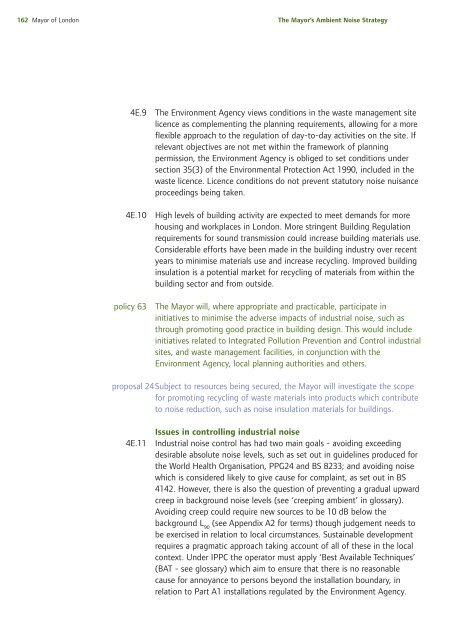The Mayor's Ambient Noise Strategy - Greater London Authority
The Mayor's Ambient Noise Strategy - Greater London Authority
The Mayor's Ambient Noise Strategy - Greater London Authority
You also want an ePaper? Increase the reach of your titles
YUMPU automatically turns print PDFs into web optimized ePapers that Google loves.
162 Mayor of <strong>London</strong><br />
<strong>The</strong> Mayor’s <strong>Ambient</strong> <strong>Noise</strong> <strong>Strategy</strong><br />
4E.9 <strong>The</strong> Environment Agency views conditions in the waste management site<br />
licence as complementing the planning requirements, allowing for a more<br />
flexible approach to the regulation of day-to-day activities on the site. If<br />
relevant objectives are not met within the framework of planning<br />
permission, the Environment Agency is obliged to set conditions under<br />
section 35(3) of the Environmental Protection Act 1990, included in the<br />
waste licence. Licence conditions do not prevent statutory noise nuisance<br />
proceedings being taken.<br />
4E.10 High levels of building activity are expected to meet demands for more<br />
housing and workplaces in <strong>London</strong>. More stringent Building Regulation<br />
requirements for sound transmission could increase building materials use.<br />
Considerable efforts have been made in the building industry over recent<br />
years to minimise materials use and increase recycling. Improved building<br />
insulation is a potential market for recycling of materials from within the<br />
building sector and from outside.<br />
policy 63<br />
<strong>The</strong> Mayor will, where appropriate and practicable, participate in<br />
initiatives to minimise the adverse impacts of industrial noise, such as<br />
through promoting good practice in building design. This would include<br />
initiatives related to Integrated Pollution Prevention and Control industrial<br />
sites, and waste management facilities, in conjunction with the<br />
Environment Agency, local planning authorities and others.<br />
proposal 24Subject to resources being secured, the Mayor will investigate the scope<br />
for promoting recycling of waste materials into products which contribute<br />
to noise reduction, such as noise insulation materials for buildings.<br />
Issues in controlling industrial noise<br />
4E.11 Industrial noise control has had two main goals - avoiding exceeding<br />
desirable absolute noise levels, such as set out in guidelines produced for<br />
the World Health Organisation, PPG24 and BS 8233; and avoiding noise<br />
which is considered likely to give cause for complaint, as set out in BS<br />
4142. However, there is also the question of preventing a gradual upward<br />
creep in background noise levels (see ‘creeping ambient’ in glossary).<br />
Avoiding creep could require new sources to be 10 dB below the<br />
background L 90<br />
(see Appendix A2 for terms) though judgement needs to<br />
be exercised in relation to local circumstances. Sustainable development<br />
requires a pragmatic approach taking account of all of these in the local<br />
context. Under IPPC the operator must apply ‘Best Available Techniques’<br />
(BAT - see glossary) which aim to ensure that there is no reasonable<br />
cause for annoyance to persons beyond the installation boundary, in<br />
relation to Part A1 installations regulated by the Environment Agency.
















